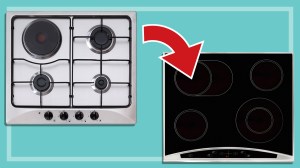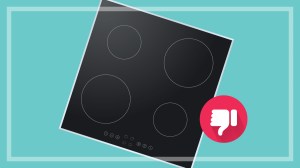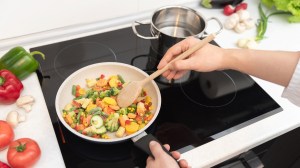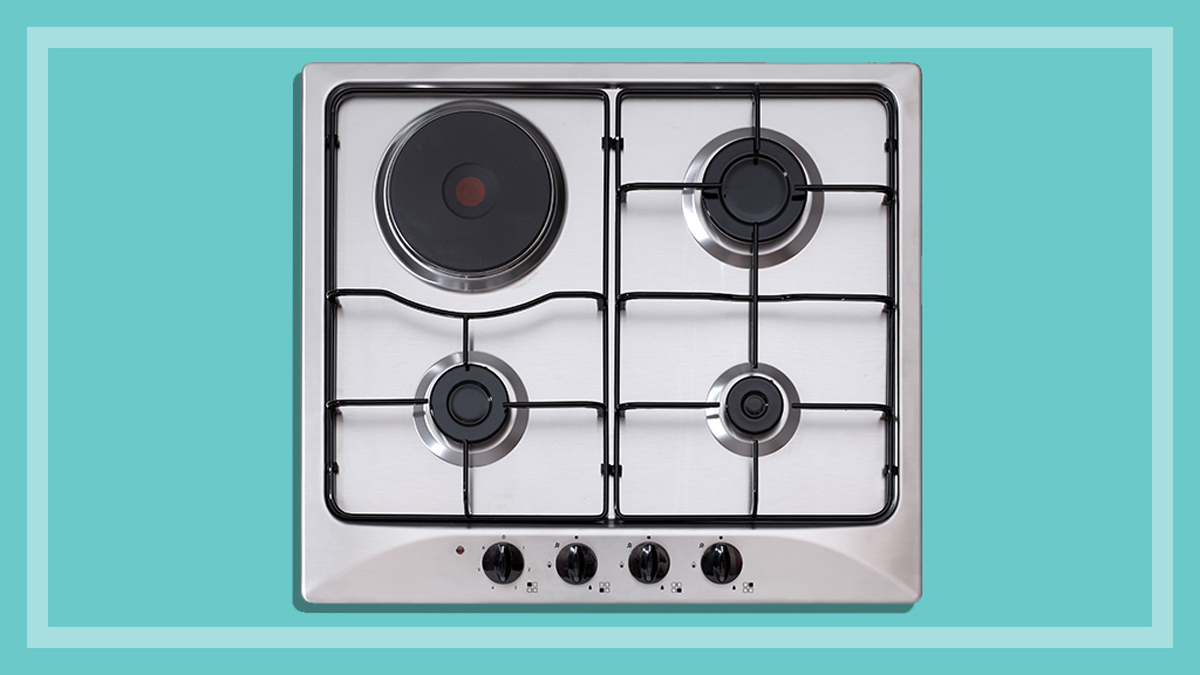
Gas vs ceramic vs induction cooktops
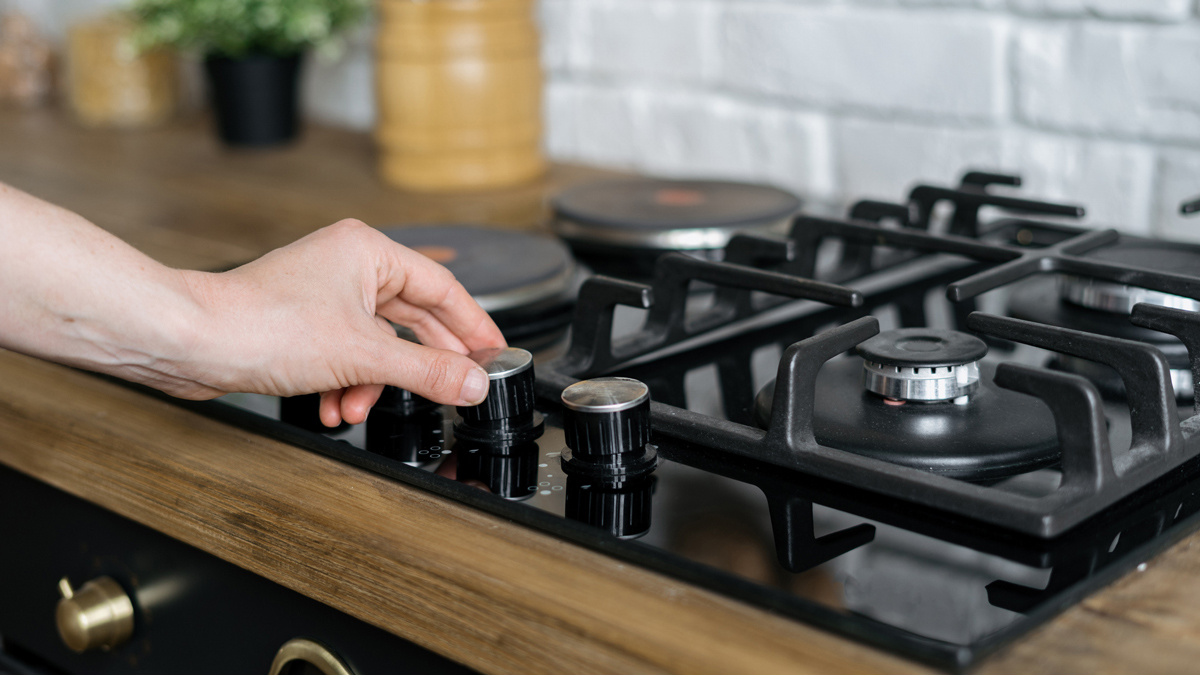
There are three main types of cooktop to choose from – gas, ceramic and induction – and each one has its advantages and disadvantages.
Whatever style you’re after, from a basic electric model to a high-tech piece of induction art, there are several big decisions to make so you don’t get burnt buying the wrong model for your kitchen.
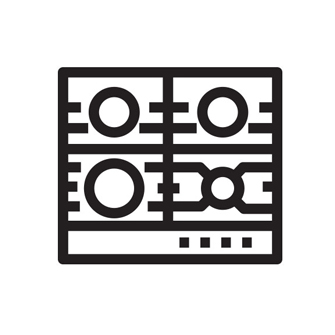
Gas cooktops: Pros and cons
If you’re after instant heat control, a gas cooktop could be the answer. Gas cooktops use an electronic ignition system that creates a spark (that clicking noise you hear) when you turn the burner on, creating the blue flame.
Turning the control knob allows you to control how much gas reaches the burner – the higher you turn, the more gas released.
Pros
- Heat is easy to control with visual feedback when you raise and lower the flame.
- Gas cooktops come in a variety of designs and finishes, including enamel, glass and stainless steel, as well as enamel or cast iron trivets.
- If you love to cook stir-fries, many gas cooktops come with a specially designed burner for woks.
- Some larger options have an oblong-shaped burner to use with a grill or hotplate for barbecuing.
Cons
- Gas cooktops must be installed by a qualified gas professional.
- They don’t have cooking timers or child locks.
- They have many parts that need to be removed for cleaning.
- Cast iron trivets can be bulky and difficult to clean.
- Glass and stainless steel finishes require more effort when cleaning.
- Gas flames release small amounts of contaminants such as nitrous dioxide, which can exacerbate asthma and other respiratory conditions.
Check that mains gas is available where you live before buying. If it isn’t and you’ve still got your heart set on a gas cooktop, you can use bottled LPG with many models, but keep in mind this is more expensive than mains gas.
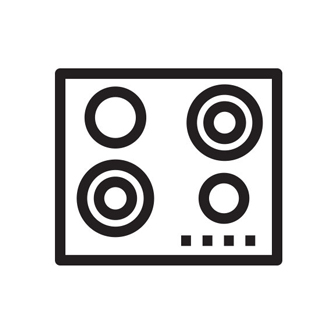
Ceramic cooktops: Pros and cons
Ceramic cooktops are worth considering if you’re after a sleek and stylish design for your kitchen. Ceramic cooktops have coiled metal elements under the glass surface and are electronically heated.
Pros
- Ceramic cooktops have a continuous surface with few to no dirt traps, so they’re easy to clean.
- They’re particularly useful for cooking foods that require very low temperatures, like melting chocolate.
Cons
- Ceramic cooktops aren’t as instantly controllable as gas – they’re slower to respond to changes in the temperature setting.
- Spills can bake on, so you need to wipe them up quickly.
- There’s often no lip around the edge of the cooktop to contain spills.
- The ceramic glass holds heat, so you need to take care with delicate foods.
- They hold heat even after being switched off – many come with residual-heat warning lights that stay on until the surface reaches a safe temperature.
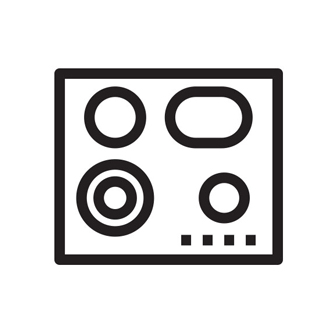
Induction cooktops: Pros and cons
For superior performance and stylish design, look no further than an induction cooktop. Induction works via a magnetic field that essentially turns your cookware into the heating element.
Pros
- Induction is the fastest cooking method and just as controllable as gas.
- Induction cooktops have a continuous cooking surface with few to no residue traps.
- They’re very quick to heat up and respond instantly to temperature changes.
- They come with many safety features like safety sensors that monitor temperature, automatic switch-off that turns the element off if the cookware is overheating, safety cut-out for protection against overspills, child locks and pan detection.
- Food is cooked via the heat of the cookware, not from the cooktop itself, so the cooktop doesn’t get hot.
- Many induction cooktops come with “power boost” for boiling water, stir-frying or searing meat. It heats up the cookware even faster, saving around one third of the normal heat-up time.
- Many come with cooking timers that can be used for programming zones to switch off automatically.
- They’re easier to clean than other cooktops.
Cons
- Induction cooktops are generally more expensive than ceramic or gas cooktops.
- There’s no visual feedback.
- You can only use certain types of cookware that are compatible with induction (suitable cookware needs to have a ferrous base).
- The size of the base of the cookware needs to closely match the cooking zone – if it’s too small it won’t respond, and if it’s too large it won’t be energy-efficient.
- They usually needs a dedicated circuit, typically 20 amp or greater, which will need to be installed by an electrician.
- You might notice some noises – a buzz or hum is common and could occur if the cookware doesn’t have a strong magnetic hold. The cooling fan for the electronics can also be the cause of some noise.
Other cooktop options
Freestanding cookers (or upright cookers or freestanding ovens with cooktops)
These combine your cooktop and oven in the one unit and can come in gas or electric configurations. Check out our freestanding cooker buying guide for more information.
Radiant coil and solid hotplate cooktops
Ceramic and induction are by far the two main types of electric cooktops but there are two cheaper options – radiant coil and solid hotplate. However, they aren’t as widely available.
Radiant coil cooktops use a coil element to heat the cookware, and those coils can be a hassle to clean. Some can be unplugged and removed while others have a hinge so you can lift them for easier access to the drip trays underneath.
Solid hotplate cooktops have a solid metal disk for each hotplate that’s slower than all other types of cooktops to heat up and extremely slow to cool down, making them difficult to control.
Making the switch from gas to induction
Gas cooktops are favoured by many home cooks and praised for their fast heat-up times, ease of temperature control and versatility with different types of cookware. However, a 2021 report from the Climate Council, Kicking the Gas Habit: How Gas is Harming Our Health, sheds light on the dangers of using gas in the home for cooking (and heating).
Poor indoor air quality can have significant negative effects on our health and some of the main culprits of indoor air pollution include household cleaning and personal care products, cigarette smoke, mould and fuel-burning combustion appliances like gas stovetops and heaters.
Swapping a gas stove for an electric one has been associated with a 51% decrease in the levels of nitrogen dioxide in the kitchen after three months
One way to reduce indoor air pollutants is to consider swapping your cooktop from gas to induction. Electric cooktops and ovens have been shown to produce significantly lower levels of air pollutants than their gas counterparts. In fact, one study found that swapping a gas stove for an electric one was associated with a 51% decrease in the levels of nitrogen dioxide in the kitchen after three months.
While there has been limited research comparing induction to electric cooktops, induction is likely to produce even fewer pollutants than electric.
Comparing the efficiency of the different types of cooktops gives you another reason to make the switch from gas to induction. To assess efficiency, our kitchen experts conduct a boil time test whereby they see how long it takes one litre of water to reach boiling point. Our test results show induction cooktops to be the most efficient, followed by gas and ceramic.

Australia’s best cooktop brand
So you’ve settled on a cooktop type, but which brand should you buy? We identify the best cooktop brands based on our test results for induction and ceramic cooktops and feedback from our members.
Our experts have tested more than 110 cooktops in the CHOICE labs over the past six years from all major brands, including AEG, Beko, Bosch, Chef, Electrolux, Fisher & Paykel, Miele, Smeg, Westinghouse and more.
Best cooktop brand for 2024: Bosch
Bosch takes out Best Brand cooktop for 2024, with strong scores in our test results in addition to being a reliable brand with highly satisfied customers.
To find out which specific cooktop models we recommend based on our test results, and to make sure you buy the best, look for products with the blue ‘Recommended’ label in our gas cooktop reviews, induction cooktop reviews, ceramic cooktop reviews and portable induction cooktop reviews.
Bosch and Fisher & Paykel were the only brands eligible for the title of Best Brand in 2024. AEG, Electrolux, Miele, Omega, Smeg and Westinghouse were also considered, but didn’t meet our stringent eligibility criteria. AEG, Omega and Smeg were ineligible as they had fewer than five models tested, while Electrolux had below average results for reliability and satisfaction. Miele was below average for reliability, and Westinghouse was below average for satisfaction.
It’s important to note that the performance of specific product models may vary quite significantly, so don’t assume that one brand’s products are the best across the many different features, functions and price points.
The Best Brand recommendation for cooktops is based on our test results for cooktops over the past six years, as well as customer satisfaction and reliability information submitted by CHOICE members on their experience with the brand.
The recommendation is given to companies with a clear lead over their competitors during the test period, and no more than two recommendations are given during each period.
Best Brand eligibility is tough – to be considered, we must have tested a minimum of five models, and a brand must have received a minimum of 50 responses to the CHOICE member survey. Additionally, brands must score a minimum of 60% and be above the average score for average test score, reliability and satisfaction for consideration.
The following criteria determines the Best Brand recommendation.
- Average test score – 40%
- Brand reliability – 30%
- Customer satisfaction – 20%
- Recommended ratio – 10%
Average test score
This measures the average score for all cooktop models tested in the CHOICE labs for each brand. Our testers assess:
- performance on low and high heat settings
- turn-down capacity (starting on high heat and reducing to a simmer)
- ease of use
- ease of cleaning
- element size, type and positioning.
For more details, see how we test cooktops.
Brand reliability
Our customer insights team surveyed over 1700 members who owned a cooktop in the annual CHOICE Product Reliability Survey about whether they’ve run into any problems with their cooktop (induction, gas or ceramic) in the past 12 months.
Customer satisfaction
Our survey also asks how satisfied members are with their cooktop. So even if a cooktop has a fault after six months, it’s still possible for it to have a high satisfaction score – perhaps the company has customer service that goes beyond expectations, or the product is simply too good, despite some performance quirks.
Recommended ratio
In order to be recommended, a gas cooktop must earn a test score of at least 80% overall, a ceramic cooktop must earn at least 85%, and an induction cooktop must earn at least 90%. The scores are made up of performance (60%) and ease of use (40%). We then calculate the percentage of cooktops that CHOICE recommends for each brand. The greater the number of models that earn a recommendation in relation to the number of models tested, the higher the recommended ratio score.
- 2023: No winner
- 2022: AEG and Bosch
- 2021: Bosch
- 2020: Bosch
- 2019: Miele
- 2018: Bosch and Electrolux
Best cooktop brand 2024: Bosch
Best Brand score
Bosch: 80%
Fisher & Paykel: 79%
Average test score
Bosch: 84%
Fisher & Paykel: 84%
Electrolux: 88%
Miele: 87%
Westinghouse: 86%
AEG: 86%
Omega: 83%
Smeg: 81%
Reliability score
Bosch: 88%
Fisher & Paykel: 83%
Electrolux: 80%
Miele: 81%
Westinghouse: 89%
AEG: 87%
Omega: 79%
Smeg: 80%
Customer satisfaction score
Bosch: 90%
Fisher & Paykel: 86%
Electrolux: 84%
Miele: 88%
Westinghouse: 84%
AEG: 85%
Omega: 76%
Smeg: 83%
Recommended ratio
Bosch: 18%
Fisher & Paykel: 33%
Electrolux: 67%
Miele: 63%
Westinghouse: 67%
AEG: 50%
Omega: 0%
Smeg: 0%
Number of tested models
Bosch: 11
Fisher & Paykel: 6
Electrolux: 9
Miele: 8
Westinghouse: 12
AEG: 2
Omega: 4
Smeg: 4
Number of recommended models
Bosch: 2
Fisher & Paykel: 2
Electrolux: 6
Miele: 5
Westinghouse: 8
AEG: 1
Omega: 0
Smeg: 0
Australia’s most reliable cooktop brands
More than 6000 members participated in our 2020 reliability survey, with 52% (3115) telling us they’d bought a cooktop brand new. The information they provided gives us a really good indication of how various cooktop brands perform over time – something we can’t test in our labs.
The top performers
Most reliable brands:
Westinghouse, Bosch, AEG
Highest owner satisfaction:
Bosch, Miele, Fisher & Paykel, AEG, Westinghouse, Electrolux, Smeg
Main problems:
Difficult to clean, problems with the igniter/ignition.
Cooktop ownership by type includes:
- 48% gas
- 34% induction electric
- 15% ceramic electric.
Benchtop cooktops have an 84% reliability score and an 85% satisfaction score across all brands, while freestanding oven/cooktop combos achieve an 80% reliability score and an 82% satisfaction score.
Although Omega cooktops are cheaper than other brands (with 56% paying under $700), its reliability and satisfaction scores are among the lowest of the brands recorded.
Of those who bought their cooktop in the eight years prior to 2020, 63% have never experienced problems, 9% complained that it’s difficult to clean, 8% had problems with the igniter/ignition, and 12% had contacted the brand for service support (49% of them did so due to a major failure).
Members also provided open-ended feedback on their cooktop brand. Bosch owners were generally happy, although there were a few complaints of the cooktop being difficult to clean. A few Westinghouse owners mentioned problems with the knobs coming off or discolouring.
Cooktop reliability and satisfaction
Reliability score
Westinghouse (225): 89%
Bosch (255): 88%
AEG (86): 87%
Fisher & Paykel (108): 83%
Miele (203): 81%
Electrolux (103): 80%
Smeg (155): 80%
Omega (61): 79%
Average (1750): 83%
Customer satisfaction score
Westinghouse: 84%
Bosch: 90%
AEG: 85%
Fisher & Paykel: 86%
Miele: 88%
Electrolux: 84%
Smeg: 83%
Omega: 76%
Average: 85%
Table notes: We calculated each brand’s reliability and customer satisfaction score based on a survey of 6009 CHOICE members, conducted in 2020. Sample sizes are in brackets. Results are based on data from 2012 to 2019 (eight years) for reliability. For reliability scores, differences of 5% or more between brands are significantly different. If your brand is missing, this means we don’t have enough owners by year group to report about reliability for that brand.
Reliability
Reliability figures are based on owner assessment, not test data. We use the data we collect from members to rate the most popular brands for reliability. We take into account the age of the products so we can compare fairly between brands.
Owner satisfaction
We asked owners to tell us what they thought of the products they own, rating them from excellent to terrible. We’ve used this information to give each brand an owner satisfaction rating so you can see what people who use the brand, day in day out, think of them.
Related

